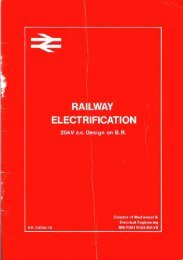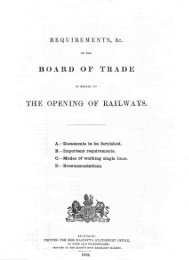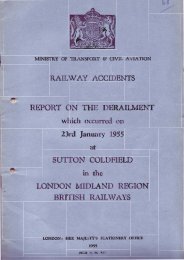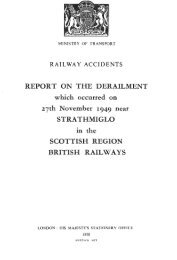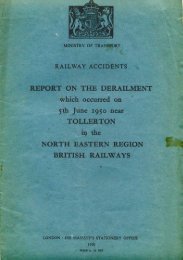R A I LT R AC K - The Railways Archive
R A I LT R AC K - The Railways Archive
R A I LT R AC K - The Railways Archive
Create successful ePaper yourself
Turn your PDF publications into a flip-book with our unique Google optimized e-Paper software.
SUMMARIES OF KEYLOCATIONS IDENTIFIED IN THE 1998 NETWORK MANAGEMENT STATEMENT WITH PREDICTED CONGESTION<br />
We are committed to working with our customers to ensure that their new vehicles can be introduced on<br />
A<br />
B<br />
B<br />
C<br />
C<br />
D<br />
E<br />
F<br />
G<br />
H<br />
I<br />
J<br />
J<br />
K<br />
LOCATION AND POSSIBLE SOLUTIONS TO CONGESTION<br />
Midland Main Line: Leicester area. We are already increasing capacity at Wigston North Junction.We are examining<br />
whether additional capacity would be required if Felixstowe–Midlands–North West freight trains are rerouted by Leicester.<br />
West Coast Main Line: Rugby–Carlisle. <strong>The</strong> West Coast Main Line modernisation project will provide additional<br />
paths,limiting growth of freight paths to the minimum agreed with the Rail Regulator. Our position is that it is not<br />
economical for the industry to provide paths for freight beyond 84 per day.<br />
West Coast Main Line: Crewe and Colwich–Manchester (Slade Lane Junction). <strong>The</strong> West Coast Main Line<br />
modernisation project commits Railtrack to providing additional capacity to meet existing and future contractual<br />
commitments.Complete renewal of the signalling between Slade Lane and Cheadle Hulme will begin in 2000/01 and this<br />
will incorporate capacity enhancements to accommodate the additional PUG 2 services.We are currently determining the<br />
scope of the layout and signalling changes required between Cheadle Hulme and Crewe.<br />
North London Line: Stratford–Richmond. <strong>The</strong> options for this route , which links the key radial routes from London,<br />
can now be identified as our strategies on the radial routes has been finalised.<br />
West London Line: Willesden Junction–Clapham Junction. We have examined a number of solutions involving<br />
increasing the linespeed over Chelsea River Bridge, the examination of the prevailing linespeed to provide a smoother<br />
profile, resignalling,the transfer of <strong>AC</strong>/DC electrification interface to a station stop, possible rerouteing of freight and/or<br />
other passenger paths,and buying out of paths.<strong>The</strong> Chelsea River Bridge linespeed solution has been proposed as the most<br />
appropriate short-term solution to reflect emerging market and customer needs.<br />
East Coast Main Line: Peterborough–Newcastle. We have committed to phased increase in capacity.<br />
Midland Main Line: Sheffield area. We are undertaking a timetabling exercise to ascertain the scope of infrastructure<br />
works necessary. Possible solutions include the doubling of the line between Dore Station Junction and Dore West stations.<br />
Great Western Main Line: Didcot–Swindon. We will implement proposals depending on emerging growth in traffic.<br />
<strong>The</strong>se include upgrading facilities for looping freight trains,increasing platform capacity at Swindon,and enhancing the<br />
signalling system.<br />
Derby–Bristol and Didcot via Birmingham: Didcot–Leamington Spa. Known customer and market<br />
requirements can be met by existing infrastructure except between Banbury and Fenny Compton.Additional signalling<br />
between these locations will provide the necessary capacity.<br />
London–Portsmouth and Weymouth: Southampton–Bournemouth. Further analysis suggests that train-path<br />
demand will not exceed capacity during the planning period.However, planned signalling renewals work will marginally<br />
increase capacity.<br />
Reading and Bristol–Penzance: Exeter–Plymouth. Further analysis demonstrates that known customer and<br />
market requirements can be met by existing infrastructure.<br />
Derby–Bristol and Didcot via Birmingham: Derby–Birmingham. Retimetabling,increasing capacity through<br />
additional infrastructure. Our analysis shows that the present information can accommodate known market and customer<br />
requirements.<br />
West Coast Main Line: Birmingham–Wolverhampton. Further analysis demonstrates it would not be costeffective<br />
to increase capacity on this route . Consequently, one customer’s aspirations will not be met.This position has been<br />
agreed with the industry.<br />
West Coast Main Line: Edinburgh: (Haymarket East Junction–Midcalder). Further analysis suggests that<br />
present infrastructure can accommodate all existing and known future customer demands.<br />
STATUS<br />
Short-term solution being<br />
implemented.<br />
Solutions being implemented.<br />
Design and development authority<br />
for Cheadle Hulme and Slade Lane<br />
being progressed.<br />
We are currently developing options.<br />
Partial solution has been proposed.<br />
Other solutions being identified for<br />
longer term.<br />
P r e fe red solution identifi e d .<br />
Options being identified.<br />
Options identifi e d . Selection<br />
and implementation subject to<br />
t ra f fic grow t h .<br />
Solution identifi e d .<br />
No solution curr e n t ly required.<br />
No solution required.<br />
Options identifi e d .I m p l e m e n t a t i o n<br />
subject to tra f fic grow t h .<br />
Solution implemented.<br />
No track capacity solution required<br />
( but overhead-line power supply<br />
a n a lysis continu i n g ) .<br />
COMPLETION DATE<br />
1999<br />
2005<br />
2002–05<br />
n/a<br />
2001<br />
2003–09<br />
2003<br />
2006<br />
2003<br />
n/a<br />
n/a<br />
n/a<br />
Implemented<br />
n/a<br />
67



